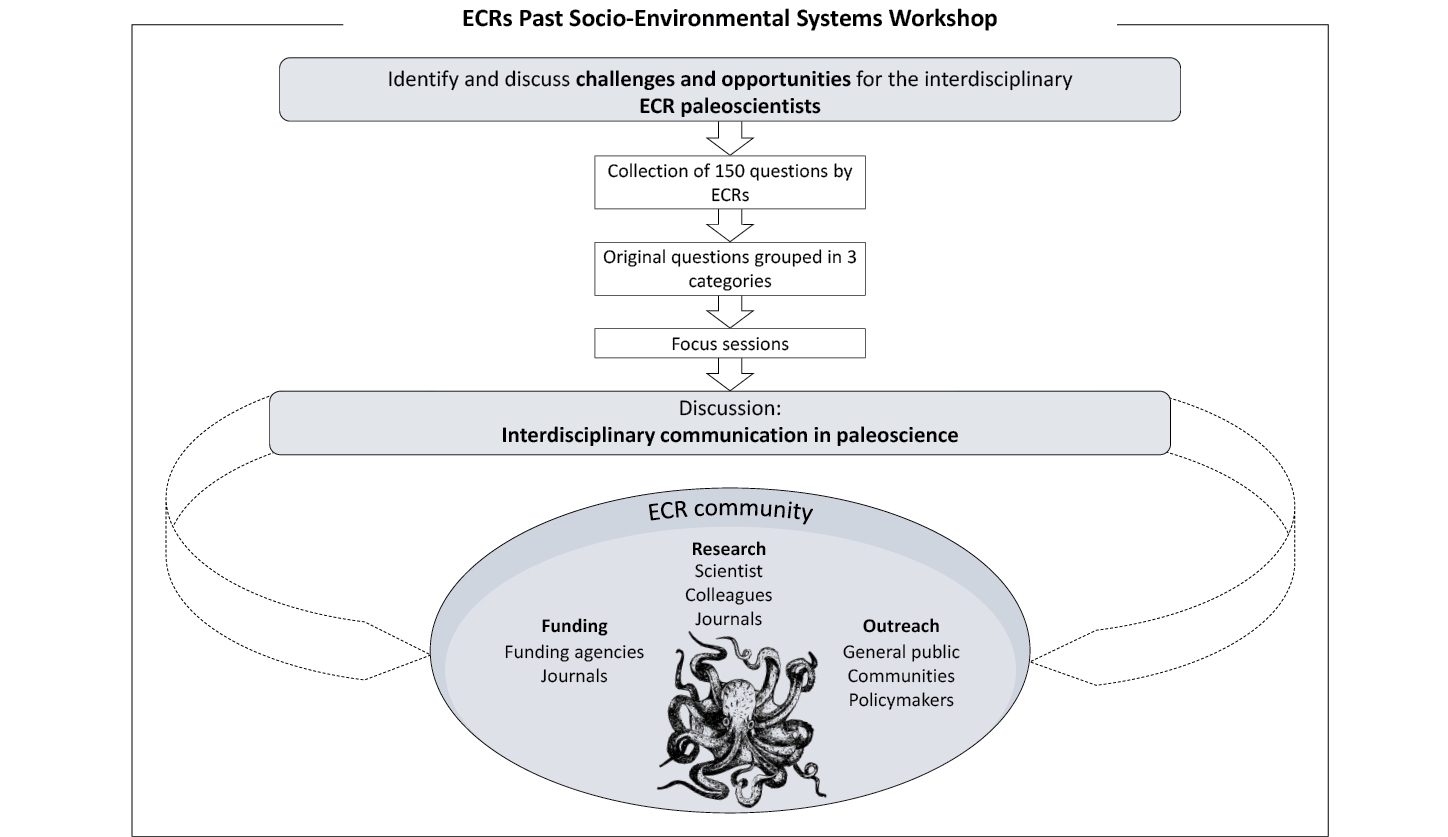- Home
- Publications
- PAGES Magazine
- Challenges and Opportunities of Communicating Interdisciplinary Paleoscience: An Early-career Researchers’ Perspective
Challenges and opportunities of communicating interdisciplinary paleoscience: An early-career researchers’ perspective
Giorgia Camperio, M.E. Castiello, I.A. Jara, T. van Kolfschoten, K. Marcisz and D. Moraga
Past Global Changes Magazine
31(1)
38
2023
In times of environmental crisis, effectively communicating scientific results to the wider public is of paramount importance (Fischhoff and Scheufele 2014). The ability of early-career researchers (ECRs) to make research accessible to different interest groups can increase opportunities for career development (Wright and Vanderford 2017).
Challenges and opportunities of communication are amplified in interdisciplinary projects, such as those addressing past socio–environmental systems (PASES) (Benito et al. 2021). Here, we compare experiences among participants of the PAGES-INQUA ECR PASES workshop, to address the overarching question: does an ECR need to be an octopus to communicate interdisciplinary paleoscience? To answer this question, we focused on three topics: research, funding, and outreach (Fig. 1).
 |
|
Figure 1: Methodological framework and discussion outcomes (symbol attribution CC0 1.0 svgsilh.com/image/1296937.html) |
Research
Paleoscience spans a wide range of different domains, and scholars often work interdisciplinarily. Publishing pressure is particularly high for ECRs (van Dijk et al. 2014). Working interdisciplinarily requires additional time investments to keep up with new literature, while the few interdisciplinary journals available challenge research sharing, and can hinder career advancement.
Communication in research is key for the success of interdisciplinary projects. However, researchers working interdisciplinarily have to overcome semantic differences encountered in the specialized language of each domain. In this context, it can be challenging to communicate interdisciplinarily at field-specific conferences, but workshops organized by ECRs for ECRs (see the workshop report by Benito et al. on p. 48 of this issue) can be a perfect setting to exchange ideas and set the initial stage to develop collaborative projects.
Funding
ECRs are caught in a loop between funding agencies and journals, where successful grant applications depend on the quality of publications, which in turn require funding to produce data. Stakes are high for ECRs who are usually under non-permanent contracts. Proposal writing challenges are common across fields, requiring an equilibrium between details and the broader picture. Interdisciplinary proposals should highlight how each discipline is crucial to answering the research questions and demonstrate the impact of research on broader issues.
Although interdisciplinary proposals allow researchers to access funding schemes that are not available to single-discipline research projects, ECRs working in low- and middle-income countries, where institutions might lack grant advice offices, can face difficulties in accessing funding schemes (e.g. ERC grants). Being part of an ECR network (e.g. PAGES Early-Career Network) can be an advantage, as members can share information and experiences, and sometimes online resources are available (e.g. webinars, see PAGES ECN YouTube channel: youtube.com/PAGESECN).
Outreach
Communication to the public is a transferable skill increasingly valued by institutes, funding agencies, and journals. Plain language abstracts in scientific journals exemplify the different communication styles required to engage with a broader audience: scientifically accurate without excessive technical detail. Storytelling helps to raise interest in complex research topics, but it is not something scientists are trained for.
Paleoscience can deal with strong barriers in outreach (e.g. climate-change deniers), but topics related to PASES can be less challenging to communicate compared to other interdisciplinary topics. They can capture the attention of the audience by highlighting how paleoscientific research connects with pressing environmental issues (Razanatsoa et al. 2017). Furthermore, most ECRs might be at ease sharing their findings on social media platforms. Nevertheless, it may become overwhelming to keep up with different social media platforms. The ECR community can help, e.g. sharing publication posts to specific working networks that reach a larger audience (e.g. @PAGES_ECN).
Conclusions and recommendations
In the three domains of science communication that concern ECRs working on interdisciplinary subjects, challenges outnumber opportunities.
Our discussion is not new to ECRs in paleoscience (e.g. Plumpton et al. 2017, Roop and Dietze 2013) and is not meant to provide solutions. We highlighted aspects that emerged during our focus session, realizing that despite our different backgrounds, we shared common challenges.
Pressure on ECRs is high, mental health is at stake, work-life balance is often precarious, and time is limited. It is not required to master each of these communication aspects, but rather acknowledge their existence and focus on the opportunities. ECRs do not have to be octopuses; they can rely on a community to complement each other.
affiliations
1Department of Earth Science, ETH Zürich, Switzerland
2Department of Surface Waters, Research & Management, Eawag, Dübendorf, Switzerland
3Institute of Archaeological Sciences (IAW), University of Bern, Switzerland
4Department of History and Geography, University of Tarapacá, Arica, Chile
5Faculty of Archaeology, Leiden University, Netherlands
6Climate Change Ecology Research Unit, Adam Mickiewicz University, Poznań, Poland
7Ecology Department, Pontificia Universidad Católica de Chile, Santiago, Chile
contact
Giorgia Camperio: giorgia.camperio eawag.ch (giorgia[dot]camperio[at]eawag[dot]ch)
eawag.ch (giorgia[dot]camperio[at]eawag[dot]ch)
REFERENCES
Benito X et al. (2021) PAGES Mag 29(1): 58
Fischhoff B, Scheufele DA (2014) Proc Natl Acad Sci 111: 13583-13584
Plumpton H et al. (2017) PAGES Mag 25(2): 100
Razanatsoa E et al. (2017) PAGES Mag 25(2): 105
Roop H, Dietze E (2013) PAGES Mag 21(2): 95